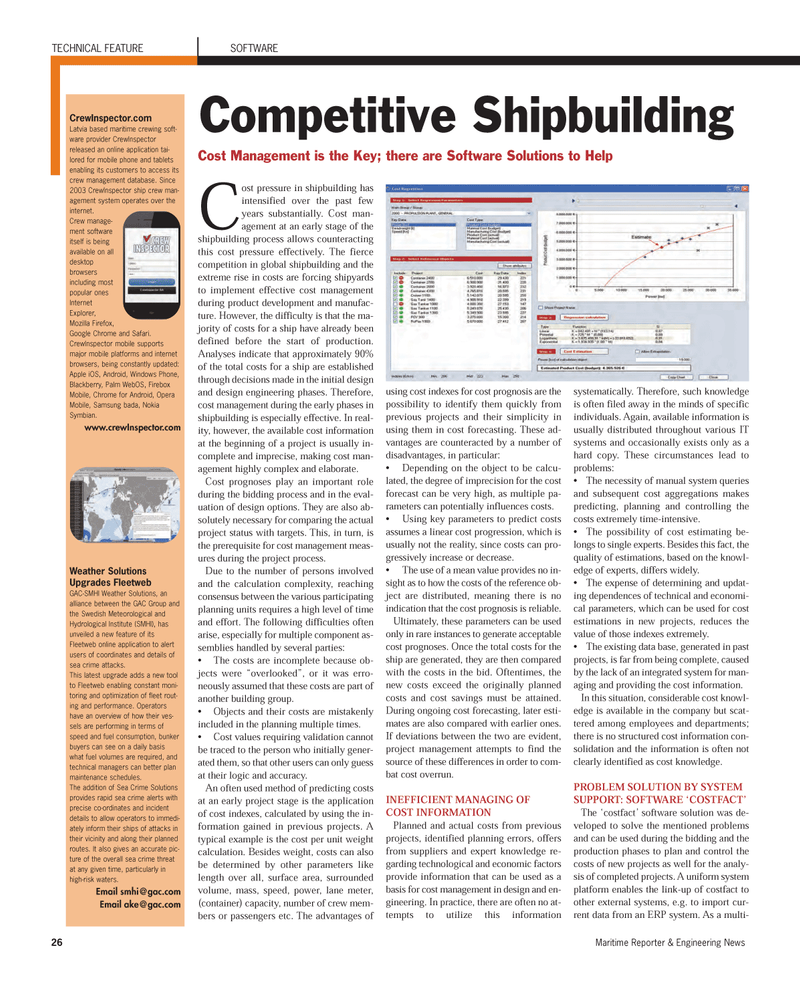
Page 26: of Maritime Reporter Magazine (June 2012)
Annual World Yearbook
Read this page in Pdf, Flash or Html5 edition of June 2012 Maritime Reporter Magazine
26Maritime Reporter & Engineering News Cost pressure in shipbuilding has intensified over the past few years substantially. Cost man- agement at an early stage of theshipbuilding process allows counteracting this cost pressure effectively. The fierce competition in global shipbuilding and the extreme rise in costs are forcing shipyards to implement effective cost management during product development and manufac- ture. However, the difficulty is that the ma- jority of costs for a ship have already been defined before the start of production. Analyses indicate that approximately 90%of the total costs for a ship are establishedthrough decisions made in the initial designand design engineering phases. Therefore, cost management during the early phases inshipbuilding is especially effective. In real- ity, however, the available cost information at the beginning of a project is usually in- complete and imprecise, making cost man-agement highly complex and elaborate. Cost prognoses play an important roleduring the bidding process and in the eval- uation of design options. They are also ab- solutely necessary for comparing the actualproject status with targets. This, in turn, is the prerequisite for cost management meas-ures during the project process.Due to the number of persons involved and the calculation complexity, reaching consensus between the various participating planning units requires a high level of time and effort. The following difficulties often arise, especially for multiple component as-semblies handled by several parties: The costs are incomplete because ob- jects were ?overlooked?, or it was erro- neously assumed that these costs are part ofanother building group. Objects and their costs are mistakenly included in the planning multiple times.Cost values requiring validation cannot be traced to the person who initially gener- ated them, so that other users can only guessat their logic and accuracy. An often used method of predicting costsat an early project stage is the applicationof cost indexes, calculated by using the in- formation gained in previous projects. A typical example is the cost per unit weight calculation. Besides weight, costs can alsobe determined by other parameters like length over all, surface area, surrounded volume, mass, speed, power, lane meter, (container) capacity, number of crew mem- bers or passengers etc. The advantages of using cost indexes for cost prognosis are the possibility to identify them quickly fromprevious projects and their simplicity in using them in cost forecasting. These ad- vantages are counteracted by a number of disadvantages, in particular: Depending on the object to be calcu- lated, the degree of imprecision for the cost forecast can be very high, as multiple pa- rameters can potentially influences costs.Using key parameters to predict costs assumes a linear cost progression, which isusually not the reality, since costs can pro- gressively increase or decrease. The use of a mean value provides no in- sight as to how the costs of the reference ob- ject are distributed, meaning there is no indication that the cost prognosis is reliable.Ultimately, these parameters can be used only in rare instances to generate acceptablecost prognoses. Once the total costs for theship are generated, they are then compared with the costs in the bid. Oftentimes, thenew costs exceed the originally planned costs and cost savings must be attained. During ongoing cost forecasting, later esti-mates are also compared with earlier ones.If deviations between the two are evident, project management attempts to find the source of these differences in order to com- bat cost overrun. INEFFICIENT MANAGING OF COST INFORMATIONPlanned and actual costs from previous projects, identified planning errors, offers from suppliers and expert knowledge re- garding technological and economic factors provide information that can be used as a basis for cost management in design and en-gineering. In practice, there are often no at-tempts to utilize this informationsystematically. Therefore, such knowledge is often filed away in the minds of specific individuals. Again, available information is usually distributed throughout various IT systems and occasionally exists only as a hard copy. These circumstances lead to problems:The necessity of manual system queries and subsequent cost aggregations makes predicting, planning and controlling thecosts extremely time-intensive. The possibility of cost estimating be- longs to single experts. Besides this fact, the quality of estimations, based on the knowl- edge of experts, differs widely. The expense of determining and updat- ing dependences of technical and economi-cal parameters, which can be used for costestimations in new projects, reduces the value of those indexes extremely. The existing data base, generated in past projects, is far from being complete, caused by the lack of an integrated system for man- aging and providing the cost information. In this situation, considerable cost knowl- edge is available in the company but scat- tered among employees and departments; there is no structured cost information con-solidation and the information is often notclearly identified as cost knowledge. PROBLEM SOLUTION BY SYSTEM SUPPORT: SOFTWARE ?COSTFACT? The ?costfact? software solution was de- veloped to solve the mentioned problems and can be used during the bidding and theproduction phases to plan and control thecosts of new projects as well for the analy- sis of completed projects. A uniform system platform enables the link-up of costfact to other external systems, e.g. to import cur- rent data from an ERP system. As a multi- TECHNICAL FEATURE SOFTWARECompetitive ShipbuildingCost Management is the Key; there are Software Solutions to Help CrewInspector.com Latvia based maritime crewing soft- ware provider CrewInspector released an online application tai- lored for mobile phone and tablets enabling its customers to access itscrew management database. Since 2003 CrewInspector ship crew man- agement system operates over theinternet.Crew manage- ment software itself is beingavailable on alldesktopbrowsers including mostpopular onesInternetExplorer, Mozilla Firefox, Google Chrome and Safari. CrewInspector mobile supports major mobile platforms and internetbrowsers, being constantly updated: Apple iOS, Android, Windows Phone, Blackberry, Palm WebOS, Firebox Mobile, Chrome for Android, Opera Mobile, Samsung bada, NokiaSymbian.www.crewInspector.com Weather Solutions Upgrades FleetwebGAC-SMHI Weather Solutions, an alliance between the GAC Group and the Swedish Meteorological and Hydrological Institute (SMHI), has unveiled a new feature of its Fleetweb online application to alert users of coordinates and details of sea crime attacks.This latest upgrade adds a new toolto Fleetweb enabling constant moni-toring and optimization of fleet rout- ing and performance. Operators have an overview of how their ves-sels are performing in terms of speed and fuel consumption, bunkerbuyers can see on a daily basiswhat fuel volumes are required, and technical managers can better planmaintenance schedules. The addition of Sea Crime Solutionsprovides rapid sea crime alerts with precise co-ordinates and incident details to allow operators to immedi-ately inform their ships of attacks intheir vicinity and along their plannedroutes. It also gives an accurate pic- ture of the overall sea crime threat at any given time, particularly in high-risk waters.Email [email protected] [email protected] June12 # 4 (25-33):MR Template 6/11/2012 4:11 PM Page 26

 25
25

 27
27
